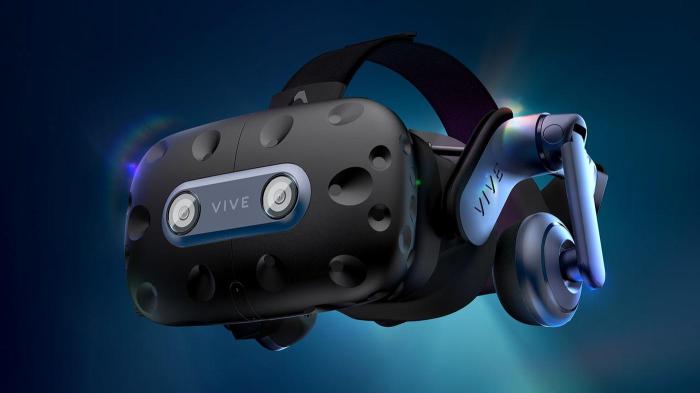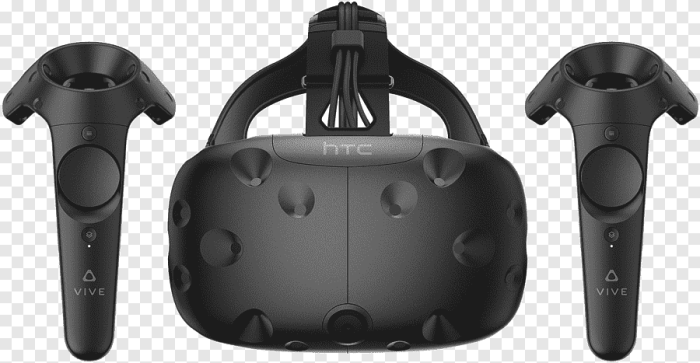HTC Vive Pro Reveal at CES 2018
The HTC Vive Pro, unveiled at CES 2018, marked a significant leap forward in VR technology. Building upon the success of the original Vive, the Pro offered a refined experience with enhanced visuals, audio, and comfort.
Key Features and Improvements
The Vive Pro brought several key improvements over its predecessor. Notably, it featured a higher resolution display, offering a more immersive and detailed visual experience. Additionally, the Pro incorporated upgraded audio technology for a more realistic and engaging soundscape. The headset also received a redesign for improved ergonomics and comfort during extended VR sessions.
Specifications
The Vive Pro boasted impressive specifications that set it apart from its predecessor.
- Resolution: 2880 x 1600 per eye (combined 3.4K resolution)
- Refresh Rate: 90Hz
- Field of View: 110 degrees
- Tracking Technology: SteamVR Tracking 2.0
Design Elements and Ergonomics
The Vive Pro featured a redesigned headset that prioritized comfort and user experience. The headband was redesigned for a more secure and balanced fit, while the faceplate was modified for improved breathability and reduced pressure points. These changes aimed to enhance the comfort of extended VR sessions, minimizing fatigue and enhancing immersion.
Impact on the VR Market
The release of the Vive Pro had a significant impact on the VR market. It signaled a continued push towards higher-fidelity VR experiences, encouraging developers to create content that leveraged the Pro’s capabilities. The Pro’s release also contributed to the growing adoption of VR in various industries, including gaming, entertainment, and education.
Vive Pro’s Performance and Capabilities
The HTC Vive Pro, released in 2018, aimed to deliver a premium VR experience with enhanced visuals, audio, and tracking accuracy. It was a significant upgrade over the original Vive, boasting a higher resolution display, improved audio, and refined tracking technology.
Visual Performance
The Vive Pro’s visual performance was a major improvement over the original Vive. It featured dual AMOLED displays with a resolution of 1440 x 1600 pixels per eye, resulting in a combined resolution of 2880 x 1600 pixels. This provided a sharper and more detailed image, with reduced screen-door effect and better clarity.
Audio Performance
The Vive Pro incorporated high-fidelity headphones directly integrated into the headset. These headphones offered immersive and accurate audio reproduction, enhancing the overall VR experience. The headphones were designed to provide excellent sound isolation, minimizing external distractions and creating a more focused VR environment.
Tracking Accuracy
The Vive Pro’s tracking accuracy was enhanced with the introduction of improved base stations. These base stations offered a wider tracking range and greater accuracy, ensuring smoother and more precise head and hand tracking. This enhanced tracking technology improved the overall user experience, making interactions within the VR environment more natural and intuitive.
Comparison with Other VR Headsets, New htc vive headset reveal ces 2018
The Vive Pro was positioned as a high-end VR headset, competing with other premium offerings like the Oculus Rift S and the Valve Index. Compared to the original Vive, the Pro offered significant improvements in visual fidelity, audio quality, and tracking accuracy. However, it faced competition from the Valve Index, which boasted even higher resolution displays and advanced tracking technology.
Potential Applications and Use Cases
The Vive Pro’s enhanced performance opened up new possibilities for various applications and use cases.
Gaming
The Vive Pro’s improved visuals and tracking accuracy made it an ideal platform for immersive gaming experiences. Games that emphasized realistic graphics, precise movements, and intricate interactions benefited significantly from the Vive Pro’s capabilities.
Entertainment
The Vive Pro provided a compelling platform for immersive entertainment experiences. Virtual reality movies, concerts, and interactive experiences were enhanced by the headset’s high-quality visuals and audio.
Professional Use
The Vive Pro’s capabilities extended beyond entertainment and gaming, finding applications in professional fields like:
- Architecture and Design: Architects and designers could use the Vive Pro to visualize and interact with 3D models, creating immersive and interactive design experiences.
- Medical Training: Medical professionals could use the Vive Pro for realistic surgical simulations and training scenarios, improving their skills and knowledge.
- Engineering and Manufacturing: Engineers and manufacturers could utilize the Vive Pro for virtual prototyping, assembly line training, and remote collaboration.
Key Features and Specifications
The following table showcases the key features and specifications of the Vive Pro compared to its competitors:
| Feature | Vive Pro | Oculus Rift S | Valve Index |
|—|—|—|—|
| Resolution | 2880 x 1600 | 2560 x 1440 | 2880 x 1600 |
| Refresh Rate | 90 Hz | 80 Hz | 144 Hz |
| Tracking Technology | SteamVR 2.0 | Inside-out tracking | Knuckles controllers |
| Audio | Integrated headphones | Built-in speakers | Integrated headphones |
| Price | $799 | $399 | $999 |
HTC’s Strategy and Position in the VR Market
HTC, a pioneer in the VR space, entered the market with the original Vive in 2016. Its strategy focused on delivering a premium VR experience, prioritizing high-quality hardware and software partnerships. This approach, however, faced challenges in a rapidly evolving market.
HTC’s Strategy and Challenges
HTC’s initial strategy involved partnering with Valve to develop the Vive, a high-end VR headset. This partnership aimed to deliver a compelling experience for developers and consumers, emphasizing high-fidelity visuals, room-scale tracking, and a strong focus on gaming.
The company also invested in content creation and development, building a strong ecosystem of VR experiences. HTC’s strategy involved creating a premium VR platform that would attract developers and consumers seeking a high-quality experience.
However, HTC faced significant challenges in the VR market. The high price point of the original Vive, coupled with the limited availability of compelling content, restricted its market penetration.
Furthermore, the rapid growth of the VR market led to increased competition from companies like Oculus and Sony. These companies offered more affordable VR headsets, targeting a wider audience with more accessible price points.
HTC’s Approach Compared to Competitors
HTC’s approach to VR, initially focused on premium hardware and software partnerships, contrasted with competitors like Oculus and Sony. Oculus, backed by Facebook, focused on a more consumer-friendly approach, offering a lower price point and a broader range of content. Sony, with its PlayStation VR, leveraged its established gaming platform to attract a wider audience.
HTC’s VR Timeline
HTC’s VR journey can be traced through a timeline of key events:
- 2015: HTC announces its partnership with Valve to develop the Vive VR headset.
- 2016: The HTC Vive is released, marking the beginning of HTC’s foray into the VR market.
- 2017: HTC releases the Vive Tracker, a device that allows for tracking of physical objects in VR.
- 2018: HTC unveils the Vive Pro, a high-end VR headset with improved resolution and audio capabilities.
- 2019: HTC releases the Vive Cosmos, a modular VR headset designed for greater accessibility and customization.
Reception and Impact of the Vive Pro: New Htc Vive Headset Reveal Ces 2018
The HTC Vive Pro, launched in 2018, was met with generally positive reception from both industry experts and consumers. While its high price point was a point of contention for some, the Vive Pro was lauded for its significant advancements in display technology, comfort, and overall performance, solidifying its position as a premium VR headset.
Initial Reception and Reviews
Early reviews of the Vive Pro highlighted its impressive visual fidelity, enhanced comfort, and improved audio quality. Publications like Road to VR and VRFocus praised the headset’s high-resolution display, offering a noticeable upgrade in clarity and detail compared to the original Vive. The improved audio system, featuring integrated headphones, was also commended for its immersive and spatial sound experience.
“The Vive Pro is a significant upgrade over the original Vive, offering a more comfortable experience and a much sharper image. It’s a premium headset that delivers a truly immersive VR experience.” – Road to VR
Impact on the VR Industry
The Vive Pro’s launch had a notable impact on the VR industry, influencing the development of future VR headsets. Its high-resolution display set a new benchmark for visual fidelity in VR, prompting other manufacturers to prioritize higher-resolution displays in their own headsets. The Vive Pro’s focus on comfort and ergonomics also contributed to the increasing importance of user comfort in VR headset design.
Pros and Cons of the Vive Pro
The Vive Pro, despite its advancements, also faced some criticism. Here’s a table summarizing the pros and cons based on user reviews and expert opinions:
| Pros | Cons |
|—|—|
| High-resolution display: Offers significantly sharper visuals compared to the original Vive. | High price point: The Vive Pro’s price tag was a barrier for many consumers. |
| Improved comfort: The redesigned headset is more comfortable to wear for extended periods. | Limited availability of compatible content: Not all VR content is optimized for the Vive Pro’s high-resolution display. |
| Enhanced audio quality: Integrated headphones provide immersive and spatial sound. | Requires external tracking: The Vive Pro still relies on external tracking sensors, which can be cumbersome to set up. |
| Improved tracking accuracy: Offers more precise tracking compared to the original Vive. | No built-in controllers: Requires the use of separate controllers, which can add to the overall cost. |
New htc vive headset reveal ces 2018 – The HTC Vive Pro’s arrival at CES 2018 was a watershed moment for the VR industry. It showcased the rapid evolution of the technology and the growing potential of VR for gaming, entertainment, and professional applications. The Vive Pro’s impact extended beyond its impressive specifications; it sparked a wave of innovation and competition within the VR market, pushing other manufacturers to raise their game. As the VR landscape continues to evolve, the legacy of the Vive Pro remains, serving as a reminder of the power of technological advancements and the potential of VR to transform the way we experience the world.
The new HTC Vive headset unveiled at CES 2018 promised an immersive experience, and with features like room-scale tracking, you could feel like you were actually in the virtual world. But even the most advanced VR tech can’t help you avoid getting lost in the real world, so it’s still crucial to have a reliable navigation tool like google maps speed limits navigation to guide you back to reality.
After all, what good is a virtual escape if you can’t find your way back to the real world afterwards?
 Standi Techno News
Standi Techno News

